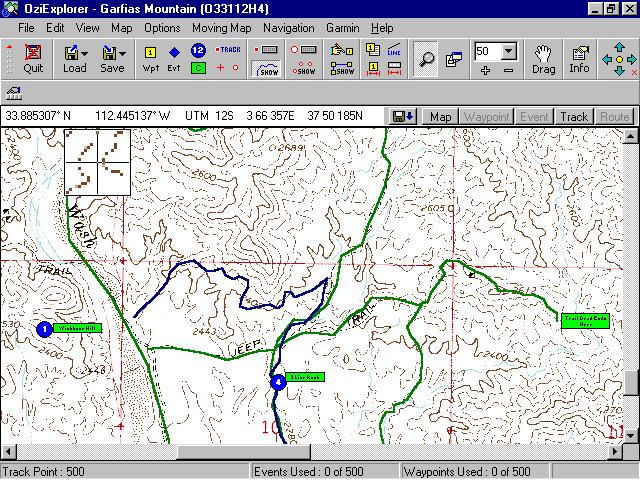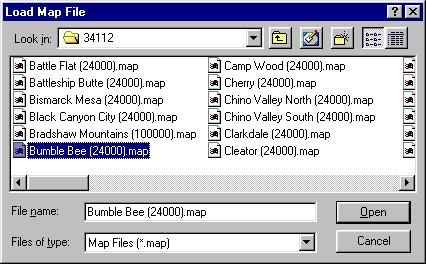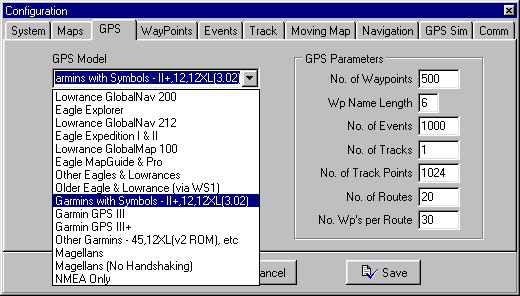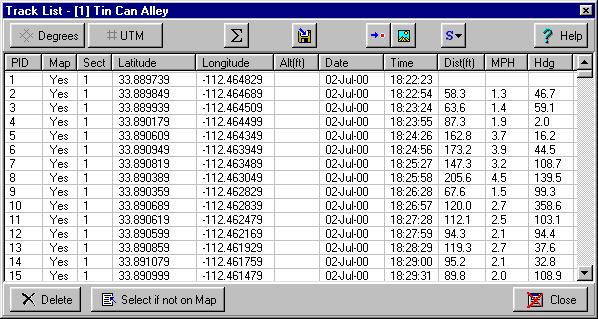During the spring of 1999, a ham-radio friend introduced me to a shareware program called OziExplorer. He is an avid 4-wheeler with a nice Jeep CJ-7. When I asked him about his use of the GPS receiver in his Jeep, he told me about this software. I downloaded the software from the Ozi web site and started playing with it. It took me only an hour or two before I was certain that this software would be a good addition to my off-road “tool box”. I spent the $65 US (now $75) and registered the software that same night. In my opinion, it is the best piece of shareware I have ever bought. Excluding my e-mail and web browser applications, it is one of the five most commonly used programs I own and is the most used application on my laptop, which now accompanies me on all of my off-road Jeep trips.
The following graphic, Figure 1, shows the main screen of OziExplorer.

Figure 1
The main screen is displaying a portion of a 7.5′ quadrangle (1:24,000 scale) map of Garfias Mountain, Arizona, which has been loaded from a USGS CD. Each 1° x 1° USGS CD has 64 of these 7.5′ topo maps on them, which make up a grid of 8×8 maps. There are a couple of 1:100,000 scale maps and a 1:250,000 scale map on each CD too. What makes these CDs so easy to use is that all of these topos come with the necessary data files that OziExplorer reads so that it can auto-calibrate each map. What does this mean to you? You simply load the map from the CD and it is ready to use…no muss, no fuss! You can even scan a map on your home scanner, save it in .TIFF format, and load it into OziExplorer. When you do this, you indicate calibration points (reference points with known latitude and longitude) on the map so that OziExplorer knows where the map is and can calculate GPS related data.
Figure 1 shows two different trails (or tracks) on it, one in blue, the other in green. OziExplorer can display up to 30 different tracks on a map. These can be loaded and displayed after the map is loaded, or a track can be made part of the map so that it appears every time the map is loaded. These tracks can be easily obtained from two sources. If your GPS receiver supports making a track plot, you can download the track data to OziExplorer after you return from an off-road trip. After you transfer the track plot data to OziExplorer, it can determine which map(s) is available for display and offer you a choice of which one to load. The other method by which you can obtain a track plot is to create one using OziExplorer itself. On Figure 1, both of these trails were plotted by me. I wanted to check the trails that were available between two locations that spanned three 7.5′ topo maps. The next time I am in this area, I will upload the track plot to my Garmin III+ receiver and see if I can run the entire trail. Uploading and downloading is done, for most GPS receivers, by simply connecting the appropriate data transfer cable (usually a serial cable connected to the PC’s comm port) to the GPS receiver. OziExplorer can transfer track plots, waypoints, routes, and events to and from a GPS receiver in this manner.

Figure 2
Figure 2 shows the Track Control screen that can be called up from the OziExplorer main screen. The Track Control is used to manage up to 30 track plots that can be displayed on a map. OziExplorer allows you to manipulate the track that is loaded as Track #1. Likewise, it is this track that is used when uploading or download with the GPS receiver. A variety of track properties, such as color, description, and plot width can be set by clicking on the Properties button.
 Figure 3
Figure 3
OziExplorer boasts a very good user iinterface, making it quick to learn and easy to use. It will upload and download data with most major brands of GPS receivers. The configuration screen, as shown above in Figure 3, shows quite a variety of GPS receivers to pick from. Lowrance, Garmin, and Magellan are all well represented. OziExplorer’s help files are very well done. Not only do they explain each and every button, field, and function of the software, but they do a fairly good job of teaching you the basics concerning map projection, datum, and other such map related terms. It even comes with a tutorial to help you get acquainted more quickly.

Figure 4
Figure 4 shows the Load Map screen. After the USGS maps have been registered with OziExplorer (this takes about 30 seconds per CD), you simply select the map from the available files. I prefer to keep all of the maps from each CD in their own subdirectory. The graphic is displaying the 34112 subdirectory, which holds all of the maps from the 34° latitude, 112° longitude USGS CD. These coordinates are the SE corner of this 1° x 1° grid. The map names and scales are all generated by OziExplorer, which obtains this information form the CD during registration.

Figure 5
OziExplorer provides quite a few map printing options. I have a Lexmark Z51 inkjet printer. With it’s 1200 x 1200 printer resolution, I can print a complete 7.5′ topo map on a regular sheet of typing paper (8.5″ x 11″). The Lexmark printer’s high resolution produces a very detailed hardcopy map. Although not absolutely necessary, I use a small 3x loop magnifier to read the “fine print” on the map. My old printer did a poor job of reproducing the fine print (it only supported 600 x 600 resolution). Even if you never plan on hooking this software up to a GPS receiver, you could save a bundle by using it to print topo maps. One of the local map stores here in Phoenix charges $6 for a 7.5′ quadrangle map. At that price, a USGS CD would cost $400. Search around on the net to find these CDs ready for the downloading from various government and educational web sites. You can copy and share these CDs with your friends. Since the CDs were produced with our federal tax dollars, they are not copyrighted. Don’t feel bad about copying them and trading with your friends. The companies that sell them are doing this very thing except you have to trade them $$ before you can get one.
 Figure 6
Figure 6
Since I have started using OziExplorer, the developer has released a significant number of upgrades to it (all free to registered users). Figure 6 shows the track editor. These are the discreet points that my GPS plotted while running a trail. As you can see, the points were taken at 30 second intervals (configured in the GPS setup) which makes for some very accurate track details unless you are traveling at a high rate of speed. Since that is not the case while wheelin’, we get very reproducible tracks that can be uploaded to the GPS when we decide to run the trail the next time.
Well, that is about it for my comments about OziExplorer. It has a lot of features and functions that I did not mention. I suggest that you download the software and go through the excellent tutorial that is included with the software. It introduces you to all of the program’s features and gives you a hand’s on experience in using the software. I guess I should say that I have no connection with the author of OziExplorer, other than I am a very satisfied user. If you use, or are thinking of using a GPS receiver, to enhance your off-road trips, I strongly suggest you try OziExplorer for your mapping software needs.
